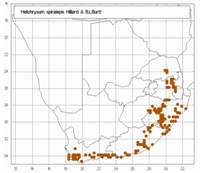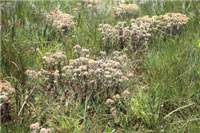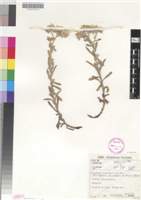Common names:
Mosuane-oa-metsie, toane-ea-metsi (SS)
Origin of name:
spiralepis = spirally arranged bracts
Diagnostic characters:
Compact flower headsBracts often tinged pink or redLeaves woolly Upper leaves forming a rosette below the inflorescenceProstrate to erect herb
Description:
A tufted perennial (?) herb, all parts grey-woolly, stems annual, often numerous, up to c. 300 mm tall, erect or decumbent then erect, simple or branched from near the base into corymbose panicles, leafy. Radical leaves rosetted, up to c. 70 x 15 mm, mostly oblong-spathulate, sometimes linear-oblong, stem leaves smaller. Heads heterogamous or rarely homogamous, c. 5 x 3 mm, narrowly campanulate, congested in small terminal glomerules surrounded by leafy bracts, glomerules rarely solitary, usually in contracted or spreading corymbose panicles. Involucral bracts in 4 series, 2 outer shorter, webbed to subtending leaves with wool, 2 inner longer, equaling or slightly exceeding the flowers, nearly glabrous, margins hyaline, tips opaque, ranging from a small apiculus to a long acuminate squarrose point, whitish, creamy, pink or red-purple, all bracts soon caducous, the whole head disintegrating. Receptacle nearly smooth. Flowers 12-36 (0-) 1-8 female, 8-27 homogamous. Achenes c. 0.75 mm long, obscurely angled, with myxogenic duplex hairs or glabrous. Pappus bristles copious, in several series, minutely scabrid, bases cohering lightly by patent cilia.
Flowering September to March depending on distribution.
Distribution:
Grows in grassland. Ranges from Table Mountain and Constantia Berg and the mountains E. and S. of Worcester along the coastal mountains to the Eastern Cape, then NE. both at the coast and inland through KwaZulu-Natal, Lesotho, the NE corner of the Free State to western Swaziland and the eastern highlands of the Mpumalanga and Limpopo; also in the eastern highlands of Zimbabwe.
Savanna, Grassland, Fynbos and Thicket Biomes.
Notes:
In the Cape, H. spiralepis always has acuminate hooked involucral bracts and hairy ovaries. In KwaZulu-Natal, this is the form that is commonest at the coast, and the only form recorded from around Ficksburg and Golden Gate in the Free State and nearby Leribe in Lesotho. It flowers between September and December and is mostly fading in January. In the Cape and KwaZulu-Natal Drakensberg and neighbouring Lesotho, the KwaZulu-Natal Midlands and Uplands, northern KwaZulu-Natal and northwards, plants with glabrous ovaries predominate. Bract tips may be acuminate to more or less acute. Flowering is mainly between January and March. The name Eriosphaera dubia was given to a dwarf form with more or less simple flowering stems, acuminate bracts and glabrous ovaries. This has been recorded from the Cape Drakensberg, nearby Witteberg and Lesotho and southernmost KwaZulu-Natal Drakensberg, (e.g. Lesotho, Sehlabathebe, Beverly & Hoener 591, NU; Maclear distr., Naude's Nek, Hilliard & Burtt 6628, E; K; NU; S). However, it grades imperceptibly into taller, more branched plants. Plants with acuminate to more or less acute involucral bracts are found along the high KwaZulu-Natal Drakensberg. In the KwaZulu-Natal midlands, only plants with more or less acute bracts are known; this form was given the illegitimate name Helichrysum involucratum. It has not proved possible to partition the variation satisfactorily on a geographic or any other basis, and H. spiralepis is therefore treated as a single polymorphic species.
Taxonomy:
Literature:
Helichrysum spiralepis Hilliard & Burtt in Bot. J. Linn. Soc. 82: 199 (1981).
Type:
Herbarium Van Royen (L, sheet 900, 346�99).
Synonym(s):
Gnaphalium scabrum L., Sp. PI. 855 (1753), non Helichrysum scabrum Less. G. squarrosum L., Sp. Pl. edn. 2: 1197 (1763). Leontonyx tomentosus Cass. in Dict. sci. Nat. 25: 466 (1822). Spiralepis squarrosa D. Don in Mem. Wern. nat. Hist. Soc. 5: 551 (1826). Leontonyx squarrosus DC., Prodr. 6:167 (1838); Harv. in F.C. 3: 205 (1865); Levyns in Adamson & Salter, Fl. Cape Penins. 786 (1950); Hilliard, Compositae in Natal 255 (1977). Type as above.
Gnaphalium connatum Spreng. in Flora, Regensburg 12, Beilage 1: 7 (1829), nomen.
Leontonyx squarrosus var. pallidus DC., Prodr. 6: 167 (1838). Lectotype: Cape, Stellenbosch, Ecklon (G-DC).
L. squarrosus var. longifolius DC., l.c. Lectotype: Cape, Burchell 4144 (G-DC).
Eriosphaera dubia DC., l.c., non Helichrysum dubium Cass. Type: Cape, Lady Grey distr., Witteberg, Dr�ge 5807 (G-DC, holo.; K; S, iso.).
Leontonyx squarrosus var. discretus Harv. in F.C. 3: 205 (1865). Type: Natal, Gerrard & McKen 272 (TCD, holo.).
Helichrysum involucratum Klatt in Bull. Herbarium Boissier 4: 461 (1896), non F. Muell. (1863). Type: [Transkei], East Griqualand, Mt Malowe, 1675 m, Tyson 3095 (Z, holo.; K; SAM, iso.).
Vouchers:
Compton 21693 (NBG); Lewis 5333 (NBG); Tyson 2948 (NBG); (all with acuminate squarrose bracts and hairy ovaries); Hilliard 4909 (E; COI; K; NH; NU; S; SRGH); Meeuse 10076 (PRE) (with acute bracts and glabrous ovaries).


